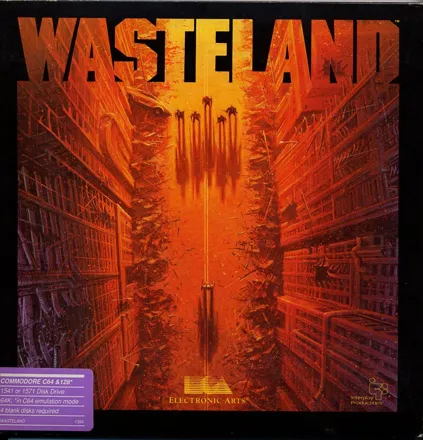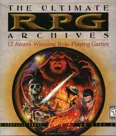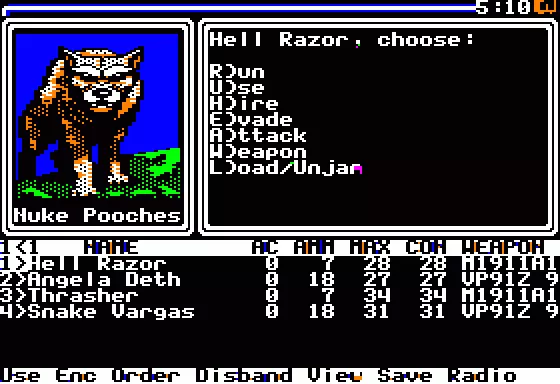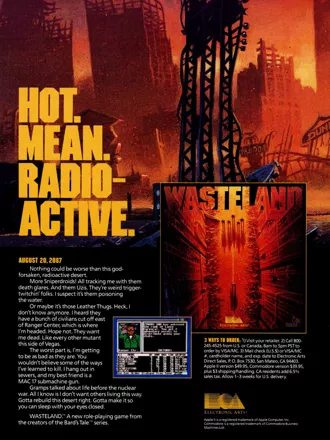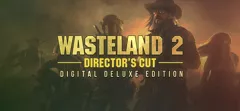Wasteland
Description official descriptions
Wasteland takes place in the future after the nuclear holocaust of World War III. The player guides band of Desert Rangers from town to town, gradually uncovering a sinister plot that threatens what's left of mankind.
Much of the game is played like most other RPGs of its time: the player navigates the party through the top-down world, fights enemies (which appear randomly in hostile areas) in turn-based style on combat screens represented by enemy pictures, acquires information, equipment, and items from NPCs in towns, etc. The player can create a whole party of adventurers and/or recruit some of the characters that populate the game's world.
However, Wasteland also introduced an original skill system that has had a significant influence on the genre. The game makes use of the skill system in conjunction with traditional character attributes to achieve goals and get past obstacles. Beside helping the characters to fight more efficiently, main attributes sometimes have an impact on activities used outside of combat. For example, high strength can be applied to break a heavy object, charisma rating might influence the way NPCs interact with the main character, etc.
The skills work in a similar way: some of them improve the characters' proficiencies with different types of attacks and weapons, while others are needed to solve and/or by pass certain situations during interaction with the game's characters and objects. These skills are rather diverse, ranging from physical abilities such as swimming to more complex actions (medic, lock-picking), or even psychological states (confidence). Skill learning and progression depend on the main character's IQ rating.
Groups +
Screenshots
Promos
Credits (Commodore 64 version)
19 People
| Design | |
| Scenario Design | |
| Graphics | |
| Testing | |
| Producer | |
| Assistant Producers | |
| Art Director | |
| Front Cover Art | |
| Package Design |
Reviews
Critics
Average score: 83% (based on 18 ratings)
Players
Average score: 3.6 out of 5 (based on 164 ratings with 13 reviews)
An amazingly inventive and detailed game that still manages to stun me when I play it.
The Good
Wasteland, seemingly, isn't too special when you first look at it - lots of guns. Radiation. Funky monsters and robots to slow you down. Like Bard's Tale after the Evil Wizard pushes the Big Red Button. So what IS it about Wasteland that makes it a game that I still get urges to play, even after beating it 5 times?
A big aspect is the setting. Even with outdated graphics, the setting sets one's imagination aflame, using familiar elements from life and including them in the game, but overlaying the horror of nuclear war on top. While some of the darker elements aren't as evident, it's still very obvious throughout the game that there is a detailed, thoughtful, and even meaningful post-apocalyptic theme everywhere.
Another element that makes Wasteland such a great game is the character development system. Most RPGs have a player select a class for a party member - but what IS a class? Does it let YOU role-play? No, the class tells you what and how to role-play. Does it enhance the game? Perhaps, but once the class is defined there's no real development OF the character - A level 1 knight has the same desires, goals, and value systems as a level 18 knight. Wasteland uses a skill and attribute based system, periodically giving a character 'points' to use on attributes and skills, as well as having skills increase through use. But moreover, the character development doesn't stop when you use up the points - many places in Wasteland allow a character to separate from the rest of the party and engage in some solo activity - maybe hooking up with a prostitute, or venturing into a cat-and-mouse game within the mind of an android. Stuff like this builds the character individually, and thus, the party. By the end of the game, I look at my characters and not only see what they are (level 20 Corporals, demolitions dude, charismatic leader, tech expert...) but what they went through... their individual victories and tribulations. This makes for a very powerful gaming experience.
In other areas, Wasteland does quite well. Graphics are average to outstanding. The play balance is nearly perfect - the advancement from one area prepares you quite well for the next, neither too hard nor to easy. Not many sounds are included, fortunately they are simple and do not get repetative. Overall, even without the character development, Wasteland is just plain fun.
The Bad
With such a positive personal slant on Wasteland, it's hard to define problems with it. In some places, the appearance of enemies is too 'generated' (they pop up out of nowhere, Bard's Tale style) and are seemingly endless. Some enemies and situations are a little too 'weird', but Wasteland isn't supposed to be about realism. Some plot elements are a little cliche, but most are handled quite well.
The Bottom Line
Wasteland is an amazing ROLE-playing game. The setting is thorough and detailed, your characters can get into all sorts of trouble, as individuals and as a party. This makes Wasteland a unique experience every time. A typical moment in Wasteland often has me saying "Kick ASS!" either from a cool plot twist, unique enemy, or unique item. Playing Wasteland works extremely well on many levels. The only way I can think of that one wouldn't like Wasteland is if one demands the game hand the player exactly what happens - i.e., if one plays a game to read a story, but hates to be curious about what just would happen if, say, I really ticked those mutant gangsters off with plastic explosive in their vault...
DOS · by George Shannon (113) · 2000
The seminal post-apocalyptic CRPG
The Good
Given the limitations of the hardware of the time, this was an amazing game which prefigured almost all the best features of the more modern title, Fallout.
The post-apocalyptic setting allowed for the combination of recognizable modern objects and weapons with a completely unknown wilderness, and the actual story was complex and interesting.
The recognizability of things was particularly important because it allowed item descriptions to be terse without failing to inform. On a 48K machine with 140K disks, keeping descriptions down to 20 characters or so allowed for a much bigger world.
The Bad
Although it was "realistic" and designed to be part of game balance, the extremely limited finite ammunition supply combined with the possibility of random monster encounters could make the game very frustrating. (Luckily, there was an exploitable design feature in the Apple ][ version that let you overcome this.)
The Bottom Line
One of those games that is original and fun to play, and seminal in the development of the industry. An engaging story and world to explore, and in every way a worth ancestor to Fallout.
Apple II · by weregamer (155) · 2003
Super game. Got it at a yard sale and was hooked.
The Good
Different ways to do things was good, such as what to do at Fat Freddy's. Weapons jammed, different things at different shops. You could blow through trash walls, and find a gang. It was random to me the first few times. I would recommend this game to others.
The Bad
Lack of cash without cheating and the Vegas sewers.
The Bottom Line
A great game if you like old games. Try it even if you aren't a old game fan. You will like SOMETHING about it.
DOS · by Joe McCarthy (1) · 2003
Discussion
| Subject | By | Date |
|---|---|---|
| Wasteland 2? | Pseudo_Intellectual (66793) | Mar 18, 2012 |
Trivia
Apple II version
The original version of this game, for the Apple II, used a clever technical trick, effectively virtualizing the huge game world onto four disk sides. Only the part of the world the player was currently capable of interacting with was actually in memory at any given time, and the rest was stored on disk. The division across disks corresponded to geographical boundaries on the world map, so there was no problem with data straddling disk boundaries.
The game shipped on both sides of two disks, completely write-protected. To play, you copied all four disk sides to your own writable floppies, and then booted off of the copy of disk 1.
Cancelled sequel
Interplay had planned a sequel called Meantime that was due in 1989 for the Apple II. Source code was virtually completed but when the Apple II market died. It was then deamed too expensive to re-write the code to the IBM.
The sequel involved the idea of time-travel and recruiting various important historic figures (think Bill and Ted's Excellent Adventure). For more information on Meantime, read "Fallout Bible issue 8" interview with Bill Dugan.
Later Interplay attempted to revive the game once more, but Electronic Arts held rights to the title. The game evolved into what we know today as Fallout, a spiritual succesor to Wasteland that, except for some minor references, is set in a different universe.
Credits
The credits listed in this entry are a hybrid; the IBM credits have been added and overlaid on the Apple credits to make a complete MobyGames IBM PC entry.
Cover
The original packaging contained a photo of the seven main developers dressed in Wasteland gear. This photo, in silohette, is on the cover of the manual and Survival Guide. (see Box Covers).
Development
Some of the mappers on Wasteland were brought on as summertime employees for Interplay and now have careers in the game industry.
Engine
The game engine used for Wasteland was also used in the pseudo-sequel, Fountain of Dreams.
Manual
Wasteland was released with a book of text paragraphs. Specific encounters would refer players to a paragraph number for a verbose description of what was occurring. To keep players from scanning the book for clues, there were two full versions of the major story. One was the actual plot of the game and the other was a decoy involving the major settings and characters but with an entirely different explanation for the events. After completing the game, you could skim through the book and get a second (albeit cheesy) story.
Packaging
Wasteland originally came out in the classic album-square EA box for the C-64 - later versions were in the more traditional small box packaging
References
- There are references to the game designers and their previous games in Wasteland. The two most common are the obvious spell references to Bard's Tale in the occult shop in Needles, and the character Faran Brygo in Vegas (obviously taken from Brian Fargo). Another obvious one is an arm patch worn by a 'Pistolero' -- it's the old Interplay logo. Finally, the room in Vegas with the Proton Ax has the initials "A.P." (for the developer Alan Pavlish) as a wall design.
- The makers of Wasteland hid their own version of the Red Ryder 200-shot Carbine Action Air Rifle in the town of Highpool. You can "seek out" and battle (and kill the disappointingly weak) Red Ryder and claim his Red Ryder Gun for your very own.
Awards
- Computer Gaming World
- October 1988 (Issue #52) - Adventure Game of the Year
- February 1993 (Issue #103) – Introduced into the Hall of Fame
- November 1996 (15th anniversary issue) - #9 in the “150 Best Games of All Time” list
- November 1996 (15th anniversary issue) – #9 Most Memorable Game Villain (Scorpitron)
Information also contributed by Adam Baratz, ClydeFrog, DreamWeaver, LepricahnsGold, Mirrorshades2k, PCGamer77, RedRyder, [rstevenson](http://www.mobygames.com/user/sheet/userSheetId,1745/), [weregamer](http://www.mobygames.com/user/sheet/userSheetId,35969/) and [woods01](http://www.mobygames.com/user/sheet/userSheetId,5217/)
Analytics
Upgrade to MobyPro to view research rankings!
Related Sites +
-
Desolation!
Home page for an LP MUD based on Interplay's CRPG, Wasteland. -
Snake Squeezins
A Yahoo! group for discussion about Wasteland. -
The "Wasteland" article at The Vault, a Fallout wiki
This is an article found on the Fallout wiki, The Vault. It mentions, among other things, that Wasteland is not the prequel to Fallout but the inspiration. -
The Desert Ranger Outpost
One of the best resources for Wasteland. -
The Wasteland Ranger HQ-Grid
Another fantastic resource for all things Wasteland. -
UHS Hints for Wasteland
Question and answer type game guide gives you just the help you need.
Identifiers +
Contribute
Are you familiar with this game? Help document and preserve this entry in video game history! If your contribution is approved, you will earn points and be credited as a contributor.
Contributors to this Entry
Game added by Trixter.
Commodore 64 added by Quapil. Apple II added by KnockStump. Linux, Macintosh, Windows added by Sciere.
Additional contributors: bassaf, Jeanne, LepricahnsGold, Patrick Bregger, Plok.
Game added October 9, 1999. Last modified August 2, 2024.
